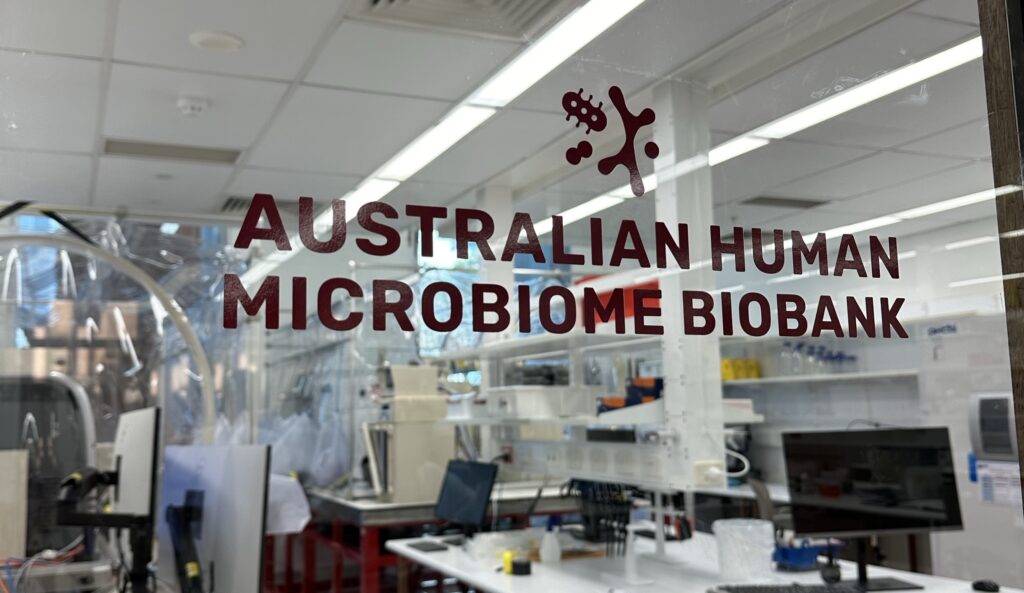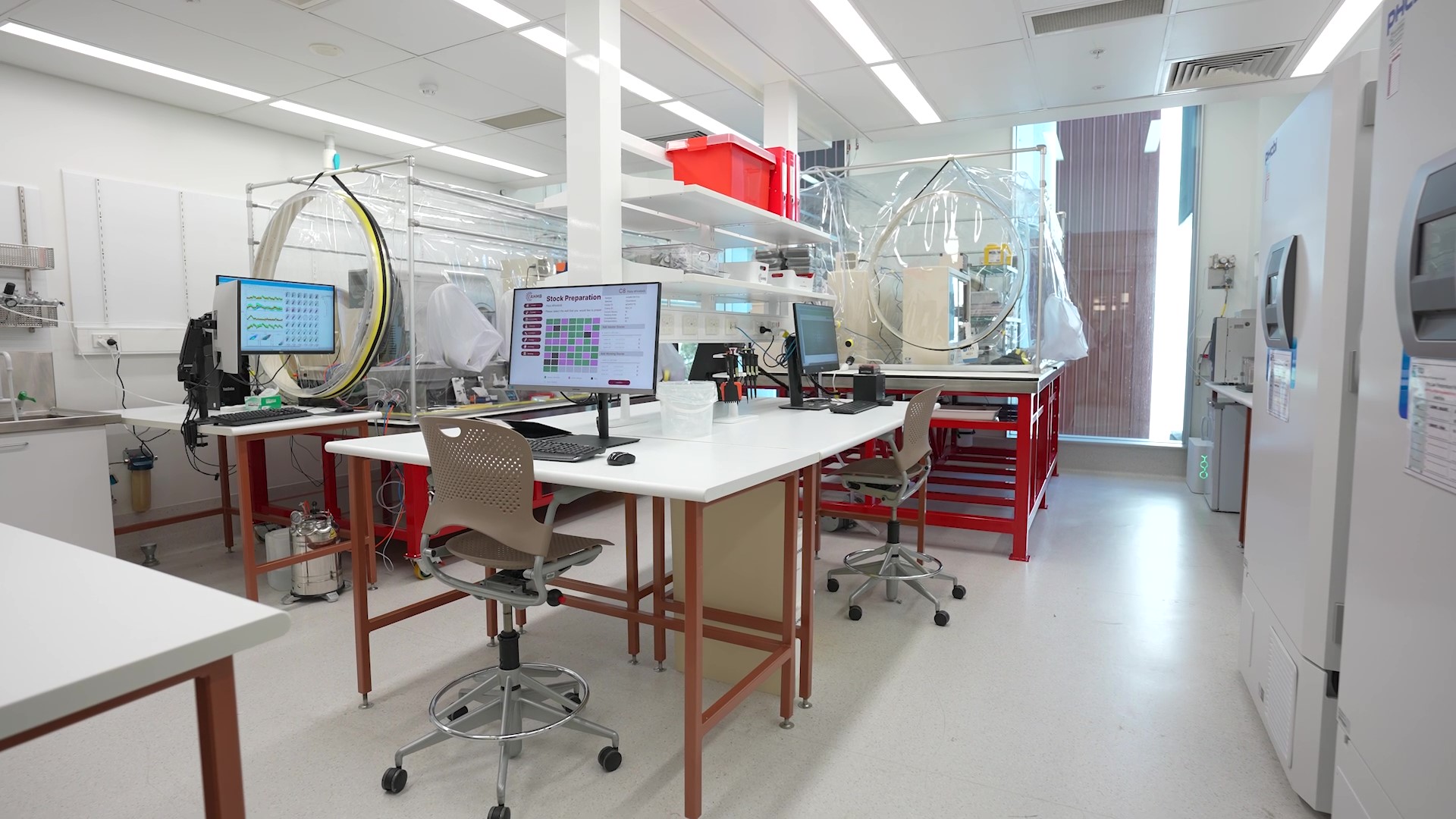The Australian Human Microbiome Biobank is a custom-built facility which allows us to isolate and cultivate microbial isolates in a high-throughput manner. The instruments we have in the AHMB enable this workflow by helping our researchers go about day-to-day biobanking duties while our machines work away. Our team work closely with these instruments, making them almost like a robotic colleague. Though they may not be able to chit-chat with us whilst we work away, we certainly believe the equipment have prominent personalities of their own. Read on to find out how the equipment helps with our daily biobanking routines, and what personalities of interest these ‘friends’ seem to have acquired.
Anaerobic chambers

Our facility houses two, custom designed and built anaerobic chambers, the largest pieces of equipment in our facility. These chambers are a key enabler to making our facility so unique.
An anaerobic chamber is a fully sealed and enclosed ‘bubble’, meaning that the environment within the chamber can be entirely different to that of our general lab space. Microbes which reside within our gut live in an anaerobic, or oxygen free environment. Our custom-designed chambers enable us to replicate this by maintaining an environment which is oxygen free and independent to the outside space. We do this by filling the chambers with a special mix of gas containing nitrogen, carbon dioxide and hydrogen, but no oxygen.
Due to the sheer size of the chambers, we are able to house multiple pieces of equipment inside, enabling our workflow to remain 100% anaerobic from start to finish as everything can be done within the space of the chamber. They are huge! This leads us to the naming of these chambers…
First up, we have the large, central anaerobic chamber, also known as ‘Big Daddy’. Big Daddy is a champion of a chamber, housing our PIXL colony picker, plate reader, conveyor belt, two incubators, liquid dispenser, shelving space, AND still has bench space for our team to work at. Certainly, a deserving name.
Our other star chamber, which is slightly smaller, but non-the-less equally as impressive, is our ‘Big Bertha’. Big Bertha is home to our Cytek Aurora CS, another critical piece of equipment within the room which is lucky enough to have an entire chamber to itself! Read further to find out more about the personalities of the other pieces of equipment which live inside of Big Bertha & Big Daddy.
Fluorescence-activated cell sorter

Our Cytek Aurora CS is a quintessential member of our team, and a concept the AHMB was based around. The Cytek, otherwise known here at the AHMB as ‘Maleficent’ or ‘Mal’, is a spectral imaging cell sorter. Mal allows us to sort individual microbial cells from a diluted mixed microbial community, such as a stood sample. So, from a sample of your stool, we are able to obtain an individual microbial isolate – isn’t that cool?! What is even cooler is that Mal gives each different microbe we sort an individual spectral profile. Using these spectral profiles, we are able to train Mal to recognise that a certain profile is associated with a particular microbe, meaning that over time Mal will be able to sort for only the microbes we have never previously isolated, and discard the microbes that we already have in our biobank.
Whilst Mal is a really cool kid and important team player in our workflow, she has quite the personality. Of course, we couldn’t name the Aurora ‘Aurora’ after the Disney princess. Though she is seriously cool, and her personality is quite fitting, this name must be common. Sorters are all about pressure, and you can learn a lot about a sorter by the noise they make, so she hisses a lot, much like a dragon. Aside from this, she also sits in a pile of gold – the AHMB aspires to be a gold resource to researchers around Australia. It is only fitting for her to be a dragon. Maleficient is the antagonist in Sleeping Beauty, who can turn into a dragon, making it a perfect name for our Cytek, whilst still referencing Aurora from Sleeping Beauty. Hence, the name Malificent came about, a name she suits quite well.
Colony picker

Another key player in our high-throughput system is our PIXL colony picker, also located within an anaerobic chamber. The PIXL is a fully automated system which will pick any colony we specify and transfer it to a new growing media. It can pick an entire plate of colonies into new media in minutes, take photos of the plate, and take photos of each individual colony on the plate. Doing this by hand would take nearly 5 minutes per bacterial colony, not per plate, our PIXL is pretty impressive.

Since our PIXL has an impressive dancing routine, with disco lights and all, we think she is a bit of a diva. For this reason, our PIXL is known as Paris. Though Paris may be a diva, she is trustworthy, sturdy, and gets the job done reliably and fast.
Other instruments

As our facility is still relatively new, some pieces of equipment are yet to be named, but are still equally as important in our workflow, such as our plate reader, liquid dispenser and incubators. As with the rest of the equipment within the AHMB, these are also located within our Big Daddy anerobic chamber. Our plate reader and liquid dispenser, in particular, are key players in our high-throughput workflow.
The plate reader enables us to measure the optical density of a colony living within the well of a plate. We use the optical density to interpret how much a colony of bacteria has grown – a high optical density means that there are likely a lot of bacteria present. With the use of the plate reader, we are able to determine the growth of 96 colonies of bacteria within mere minutes!
Our liquid dispenser allows us to add small volumes of liquid into many small tubes much quicker than we could ever accomplish by hand. The WELLJet liquid dispenser can dispense liquid in a sterile manner into 96 tubes within 30 seconds, far quicker than we could possibly do by hand! Speedy!

Finally, our incubators assist in maintaining the appropriate environment for bacteria to grow in. Whilst the bacteria we grow are happiest in an oxygen-free, or anaerobic environment, they also like to be kept warm. We maintain our bacteria at 37oC inside of the incubators for a happy growing experience.
Outside of the chambers, you will also find our freezer storage – our chambers aren’t quite big enough to fit a freezer…! Once our isolates are ready for storage, we put them into specialised tubes. These tubes must be both able to withstand very low temperatures, as we use ultra-low, -80oC freezers, but also must keep the contents of the vial at anaerobic conditions since the vial is being moved from the anaerobic chamber into the freezer.

So, not only does our high-throughput protocol make the Australian Human Microbiome Biobank a one-of-a-kind facility, but so do our instruments. Since our lab is a fully custom-designed space, we are fortunate enough to have some impressive, specialised equipment which will assist us in growing bacterial species which have never been discovered previously by other laboratories. We feel very privileged to have been able to build the AHMB as it stands, and are thankful for our sponsors, collaborators and MRFF grant funding for assisting in making our dream a reality. Here’s to some cool science to come!

